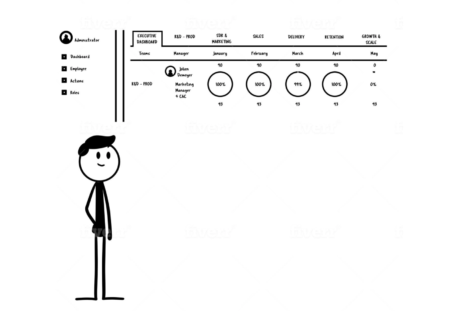How To Track Your Team’s Performance: SMART Goals

The article below is just a small glimpse into our new book. If you want to learn a lot more about SMART goals, click here to check out the book now.
Trying to wrap your mind around everything a marketing team does can be daunting. Of course we’d like to accomplish everything right now, but too often we experience what is known as “task overwhelm”. And nothing gets done. Common mistakes include going too granular or too wide and neither the smaller or the bigger projects gain enough momentum. Then we eventually get frustrated and give up. But giving up isn’t the answer, of course. The answer is to focus on one thing.
One of my favorite focus tools is the life dashboard from scaleurs.com. Use it to scale your team by dedicating only one simple KPI per team member. This is the tool we used at CHD Expert: Every team member is responsible for reaching their personal goal each year, which is evaluated into a SMART goal weekly and monthly.
What are SMART Goals?
SMART goals must meet the following criteria and can be used to determine your KPI:
- Simple – People need to know it and remember it easily.
- Measurable – There must be an objective way to determine whether or to what extent you have achieved your goal.
- Achievable – Don’t aim so high that the goal can’t be reached or so low that employees are left with nothing to do.
- Realistic/Relevant – Every goal must relate to your function or service.
- Timewise – Deadlines should be short, realistic, and finite.
SMART Goals for Marketing Teams
For example, a content writer’s goal is to attract the interest of consumers. Their KPI would be: Write five valuable content pieces per week, 20 pieces per month, or 240 pieces of content per year. Breaking the yearly goal into a smaller chunk (five per week) will still yield an impressive 240 pieces at the end of the year — writing five pieces of content per week seems a lot more manageable than 240 pieces per year.
For a social media manager, the goal would be to target the right companies and business profiles using what the content writer produces. KPI: Win five MQLs (marketing-qualified leads) per week, 20 MQLs per month, or 240 MQLs per year.
The PPC manager ensures that people find the company on Google and visit the website by fulfilling their goal of improving the company’s keyword ranking. Meanwhile, the goal of the website developer is to erase all the friction a customer might encounter when spending time on the website (e.g., incessant pop-up ads, buttons that are not clickable, links do not work, information is hard to find, etc.) so a customer can be converted into an MQL.
Wouldn’t it be great if, as a company, you suddenly could gain 240 new customers in a year?
Do you follow the logic? Everyone might have a different KPI, but together, they are striving for the same overarching marketing goal: getting more qualified demos to reduce the Customer Acquisition Cost. The content writer must write good content so the social media manager can target and capture the right leads, and so on.
This snapshot of the dashboard for scaleurs.com could be helpful:

If your team is coordinated in what they have to do, then the right tools can take them even further. Check out our FunnelIQ tool here. It might be just what you need!
Expanding Your Marketing Capacity
One of the challenges small companies might have is that the marketing department consists of only one team member or a small team. As discussed above, outsourcing is a good way to expand the talent pool.
At CHD Expert, the marketing team comprised three people. I used a great Danish company called Web 2 Media (W2M) to supplement our compact team. W2M has different sub-departments to deal with all the above functions and account managers who serve as a go-to. At CHD, I worked with consultants from W2M’s social media team, their pay per click, and the analytics team. Together, they strongly supplemented and contributed to our in-house team.
Staying lean doesn’t mean running your team (or yourself) into the ground. As your marketing business begins to scale, it can create an atmosphere of uneasiness and instability for everyone. Keep your top talent from looking elsewhere by holding regular check-ins and taking their feedback seriously. Recognize them for their hard work and celebrate the effort they’re putting in to help your business grow. Scaling is an opportunity to give employees more responsibility, and even expose them to new parts of the business they haven’t worked in before. Including them in product planning and projects like your strategic roadmap will help them discover new skills and prove that their input matters. They’ll have a sense of ownership — and be there when your business fully transforms from small to scaled.
Patience, Test, Grow
A little bit of patience with your reps can go a long way. There is no magical “on” switch for scaling a marketing team. Just like adapting to a company is a learning experience for your new hires, scaling is a learning experience for budding businesses. Scaling doesn’t happen overnight. Don’t overextend yourself too much at the beginning of the process. Scaling a marketing team takes time.
Become a Successful Scaleur
Scaling is a strategy that can only be mastered by a scaleur who is a dedicated learner and considers real-time business priorities. I hope the article above has helped! Marketing Scaleurs is a scaling company that helps entrepreneurs scale their marketing efforts. We’re experts in growth marketing, product development, and more, creating custom growth plans for startups, entrepreneurs and scaleurs in order to help them gain traffic, generate leads and increase their revenue.
If you want traffic, leads and sales, get in touch and you’ll start getting results in no time!


